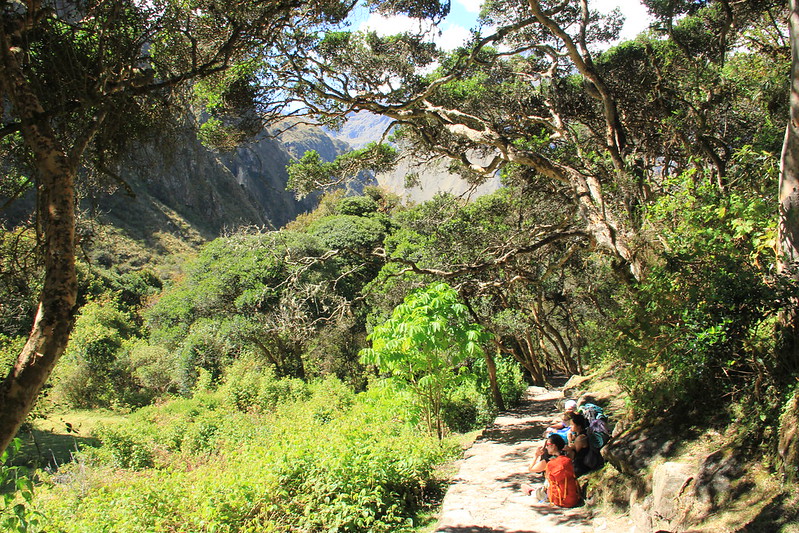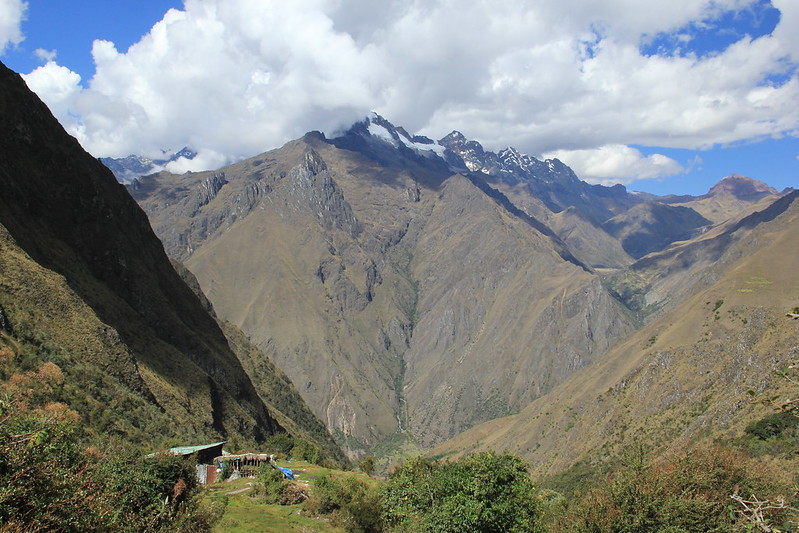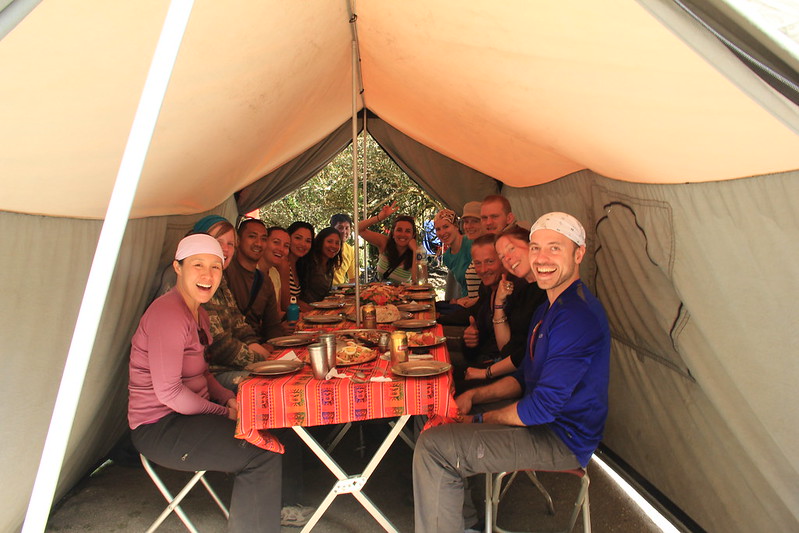When I was back in England earlier this year, perusing travel blogs and marvelling at photographs in magazines or on Pinterest, hiking the Inca Trail was the experience I was most looking forward to above all else. It was one of the major reasons I wanted to travel to Peru in the first place.
The 4-day trek follows ancient trails laid by the Incas, as they snake their way through the Sacred Valley, passing stunning mountain vistas, pre-columbian ruins, lush cloud forests and subtropical jungle, and culminates at the spectacular ancient Incan city of Machu Picchu. It’s not an easy hike though – the trail begins at 2700 metres above sea level, and ascends up to 4200 metres. Hiking at these altitudes is tough.
Even if you’re fully acclimatised (and I would NEVER advise attempting the Inca Trail trek if you’re not; more on how to successfully acclimatise to the altitude here), the shortage of oxygen can affect your energy levels, and the ease with which you can move your limbs, leave you short of breath, cause you to feel dizzy and light-headed, and bring on a headache which can increase in severity the higher you climb.
Before arriving in Peru I’d hiked up to an altitude of 2650 metres in the Picos de Europa, and my skiing trips to the Sierra Nevada mountain range (also in Spain) had seen me descending from heights of around 3000 metres above sea level, but this was nothing in comparison to the summit of the Dead Woman’s Pass, which lay 1200 metres above the pinnacle of my experience thus far.
So, not only was my interest peaked by the fascinating history of the Incan civilisation, and the stunningly diverse and beautiful landscapes through which the trail passed, but I also relished the fact that the altitude presented a physical – and potentially also a mental – challenge for me.
Call me crazy (Stu does!), but I love feeling that sense of accomplishment at the end of a good hike.
Unfortunately the Inca Trail is no longer the hidden gem it once was; it’s now the most famous hike in South America, and access to the route is strictly controlled. Just 500 permits are issued per day, and these not only include paying customers, but also guides, porters and cooks.
In order to secure a place on the exclusive Inca Trail trek, you’ll need to book months in advance. How many months is dependent on what time you year you want to hike the trail, but as an example we booked our June trek in December, because all of the May dates had already sold out.
Sure, there are alternative treks, such as the Lares or Salkantay, which also culminate in your arrival at Machu Picchu, and these can be booked just days in advance for a fraction of the price. However, I had my heart set on the classic Inca Trail, so – despite the fact that it set me back a whopping $580 (not including sleeping bag hire, porter services and tips) – that’s the one I chose to do.
The fact that we’d been in Peru for 2 months by the time we began the trek worked in our favour. We’d battled through the effects of altitude sickness on the Laguna 69 one-day hike in Huaraz, and since then, despite remaining at altitude since leaving Huaraz (our lowest (literally, not figuratively) point between Huaraz and Cusco was Ayacucho, which sits at 2750 metres above sea level), we’d not suffered any ill-effects from the altitude.
So, by the time we came to start the trek I wasn’t worried about how well my body would cope with hiking at altitude (the summit of the Laguna 69 hike was 4600 metres above sea level); the only concern I had was that the experience would not live up to my (incredibly high) expectations.
We arrived in Cusco a whole 5 days before our trek – ample time to gather additional supplies (I purchased a waterproof poncho to protect me and my day pack in case it rained; fortunately it didn’t), pay our remaining Inca Trail balance, attend a pre-trek meeting, and explore the beautiful, imperial city, with its charming colonial buildings, cobbled streets, inviting cafes, and quirky boutique shops and galleries.
On the (very early) morning of the start of our trek, we tiptoed around our hostel in the dark, attempting to wash and dry our hair (it was going to be 4 days until we saw a shower again), and cram both our backpacks into one of the available lockers, ensuring that we’d not forgotten anything vital we may need on the trek.
Unfortunately our attempts to be quiet were in vain the moment I walked into the glass door. Glass doors are a stupid idea, especially when it’s dark. Because it was dark, I was half asleep, and I wasn’t expecting the door to be there, I hit it with some force. It hurt. I screamed. Everyone in the nearby dorms woke up. And then as a result of the shock of the whole incident, I started crying.
So I left the hostel just before 6am, feeling embarrassed and in pain, with a swelling on my forehead. I put my hat on to cover the bump and hoped this wasn’t going to be a sign of things to come.
The trek began at Km.82, just outside the quaint village of Ollantaytambo. There were 35 of us altogether – 13 trekkers (7 Americans, 1 Mexican, 2 Swedes, 1 Belgian, and 2 English), 2 guides (Juan and Ronan), 1 cook, and 18 porters carrying everything from tents and sleeping bags to cooking equipment and enough food to feed all of us for the duration of the hike.
Once we’d passed through the control station, had our passports checked against our permits, and received our new passport stamps (not quite sure how this worked, it being part of Peru ‘n’ all, but hey I wasn’t about to complain!), we crossed the bridge and headed uphill.
The first day of hiking was a good introduction to what lay ahead. It wasn’t a difficult climb, but a gentle – albeit continuous – ascent. It gave us all ample opportunity to chat to other members of the group whilst we walked, and to begin to discover some of the excellent camaraderie that we’d share throughout the duration of the trek.
Some of us were simply visiting Peru with their limited annual leave allocation at work, whereas others (Stu and I included) were hiking the Inca Trail as part of a more longer term trip around Peru, and other areas of South America. It was interesting to learn about others’ backgrounds, stories and experiences, and how they compare to my own.
The track passed through a small populated village where we were able to grab some drinks and snacks at hugely inflated prices (this was the last place we’d be able to top up our water supplies before we arrived at the campsite that evening), and then continued on to the ruins of the Inca hill fort, Huillca Raccay.
Along the way we were also treated to some spectacular views of Cordillera Urubamba and the snow-capped peak of Veronica, which stands at 5860 metres above sea level.
However the highlight of the afternoon for me was looking down upon the ruins of Llactapata, a terraced Inca site (believed to be an administrative or ceremonial centre) carved into the mountainside.
Our guides (particularly our head-guide, Juan) possessed a wealth of information about the significance of each historical site we passed, and about the beliefs and practices of the Incan civilisation. Bearing in mind that they’d both walked this route on countless occasions with hundreds of different tour groups, I was stunned by the endless enthusiasm with which they imparted their knowledge at every available opportunity.
Leaving Llactapata we continued our ascent for a further 7 kilometres – following the left bank of the river Cusichaca – to the village of Wayllabamba, where we would spend the night.
Although we had trekked as a unified group for the majority of the day, the final stretch had seen the 13 of us separate into distinctive tribes based on our speed and ability (I won’t say fitness levels because altitude can affect even the fittest among us).
Having previously trekked comfortably up to an altitude of 3800 metres above sea level, Stu and I were finding today’s gentle ascent up to 3000 metres relatively easy, and managed to retain our positions towards the front of the group. As a keen photographer, this allowed me to make regular stops to capture the beauty of the surrounding landscapes, and still feel confident that I’d be able to catch up. The real test of course would be day 2, which would see us climbing a massive 1200 metres up to the Summit of the curiously-named, Dead Woman’s Pass.
When we arrived at our campsite, our tents had been expertly set up in advance by our amazing group of porters. There were relatively (in comparison to the rather dubious bathrooms we encountered on the rest of the trip) clean toilet facilities (including a western toilet), and a large bucket filled with ice that contained chilled water – and beer!
I thought we’d been lucky with the quality and variety of food we’d been served at lunch, but dinner proved to be even better. As we all gathered around the table in our dining tent, I was blown away by the sheer complexity of the dishes that were served to us, using only very basic cooking facilities and equipment.
We shared some post-meal beers with the rest of the group, and shivered our way through conversations and laughter as the post sunset temperatures began to drop, forcing us to don layer upon layer in order to combat the cold. We finally retired to our tents at around 9pm, having been awake since 4:30am and being all to aware of the challenges that lay ahead of us the following day.
Day 2 started well, and would turn out to be my favourite day of the 4-day trek. I’d slept well, and awoke to the sound of Ronan’s voice outside my tent, as he handed me a warm mug of coca tea. We enjoyed a breakfast of hot porridge, fresh fruit and pancakes before setting forth into the chill of the dawn air.
The ascent was immediately much steeper than the previous day’s and we soon felt glad to be walking under the shade of the trees above us.
Today’s climb was completed in 3 different sections. Firstly we followed the left bank of the Llulluchayoc river as far as ‘Tres Piedras’ (three stones), where we crossed a small bridge over the Huayruro river. This river is named after the large ornamental tree under which we rested at a nearby campsite.
It was here that our guides prepared some coca leaves for us, together with a solid black substance which Juan called the ‘activator’. We were then instructed to insert the roll of coca leaves (which contained a little of the activator crumbled up inside) into our mouths, chew it a little to trigger the activator, and then to keep it in the upper part of our cheeks beside our gums. Juan informed us that if our mouths started to feel a little numb (sound familiar anyone?), that was perfectly normal and meant that the coca was working.
So, sufficiently drugged up on cocaine coca, we continued on our way. Chewing coca leaves (with or without the activator) is a very effective method of combatting the effects of altitude, because they act as a mild stimulant to overcome fatigue, hunger and thirst.
A further 3 hours of trekking through steepening woods and increasingly spectacular terrain brought us to the top of the treeline and a meadow named Llulluchapampa (3680 metres), where we would stop for lunch.
Now I’m not going to lie; this section wasn’t easy. The ascent was steep, continuous, and there were A LOT of steps. However the sheer diversity of landscapes through which we passed was nothing short of amazing, and softened the blow to my leg muscles – which hadn’t been worked this hard for a very long time.
There were gushing streams and waterfalls, dense vegetation and gnarly trees, unusual plants and colourful flowers, and at the top of the climb we were rewarded with some incredible mountain vistas. The only person who beat Cara and I to the campsite was Stu, who’d already cracked open a beer by the time we’d arrived!
Along with the enjoyment of yet more delicious food came the harsh realisation that we were only halfway towards the peak of today’s climb. Despite the fact that I’d worked muscles in my legs that I never knew existed, I was feeling positive and energised, and excited about the challenge that lay ahead.
I’m a firm believer in the strength and power of the mind, and its ability to overcome physical challenges. Every part of my determined, tenacious mind wanted to be the first in our group to make it to the top of Dead Woman’s Pass, so that’s exactly what I did.
I was joined at the summit by the amazing Cara (both of us helping to spur the other on, gasping for breath as we neared the summit), and we were closely followed by José, Stu, Carmen and Wendy.
Of course, we couldn’t begin our descent until we’d taken the obligatory group shot (thanks Juan!)
From 4200 metres, we then had a 600 metre descent ahead of us. However, this paled into insignificance in comparison to this morning’s venture, so we took it in our stride.
Part the way down we were rewarded with an unusual and unexpected wildlife sighting. Stu had spotted one of these creatures in the woods during our earlier climb, but as a result of the low light under the shade of the trees I was unable to snap a clear photograph. I wasn’t going to miss my opportunity this time.
As we neared our final destination for the day, the skies darkened and the clouds began to roll in.
By the time we arrived at the campsite at Pacamaya there was a definite chill in the air. We wrapped up in every single item of clothing we’d packed, and sat around the table together in the dining tent, our hands encasing mugs of hot coca tea. Together we shared the highs and lows of today’s challenges, our muscles aching and tired, but our minds buzzing from the sum of everything we’d achieved.
Is the Inca Trail on your bucket list?
If you’re interested in learning more about the logistics, costs, tips, and practical information and advice regarding the Inca Trail, I have written a lengthy post about this over at Backpack South America.
Stay tuned for part two of my Inca Trail adventures next week!
If you like this article, please follow along on Facebook, Twitter, or Google+ or you can look me up on Instagram or Pinterest too!
This is part of the #SundayTraveler link-up, hosted by Chasing The Donkey, Pack Me To, A Southern Gypsy, The Fairytale Traveler, and Ice Cream and Permafrost.



































4 Comments
Hi Kiara, I found you through Annie Anywhere’s feature on new travel bloggers. I’m on the list too 🙂 I saw on your Flickr page that you were in Machu Picchu June 4th. Hey guess when I was there? June 5-6! I hiked the Inca Trail with Peru Treks as well. Loved going through your account of the trip and looking at your photos!
Aww, wow! You did it right after us then! I’m guessing you didn’t have the same guides though? Juan and Ronan probably needed a bit of a break before doing it all again! 😉 Have you written a post about your experiences on the trek? (I see you have one about how to train for the Inca Trail, which I’m going to read right after leaving this comment) I’d love to read it to see how our experiences compare 🙂
I’m looking forward to checking out your tips and other blogs. Machu Picchu has been on my list for a while- hopefully next year!
Machu Picchu was amazing! It totally lived up to all my expectations 🙂